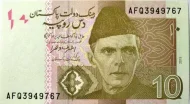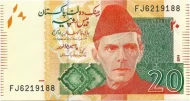Exchange your Pakistani Rupees
Do you have leftover Pakistani Rupees? We offer a fast and easy way to exchange both current and withdrawn Pakistani Rupees banknotes and coins. Convert them into your local currency today with our quick and hassle-free exchange service.
Rs - PKR
The Pakistani Rupee has been in use since 1947 and continues to support Pakistan’s economy, particularly in the areas of trade and agriculture.
Pakistani Rupees Information
The Pakistani Rupee (PKR) is the official currency of Pakistan and has been in use since the country’s independence in 1947.
The Rupee was initially introduced to replace the British Indian Rupee, and over time, it has become a symbol of Pakistan’s sovereignty and national identity.
The word “rupee” is derived from the Sanskrit word “rūpya,” meaning “wrought silver,” reflecting the historical significance of silver coins in the region.
The Pakistani Rupee is subdivided into 100 paisas, and the currency is issued in both coins and banknotes. Coins are available in denominations ranging from 1 to 5 rupees, while banknotes are issued in denominations of 10, 20, 50, 100, 500, 1,000, and 5,000 rupees. The designs on Pakistani Rupee banknotes feature prominent national figures, historical landmarks, and cultural symbols, including portraits of Muhammad Ali Jinnah, the founder of Pakistan, as well as depictions of important architectural sites such as the Badshahi Mosque.
Pakistan’s economy is diverse, with key sectors including agriculture, textiles, manufacturing, and services. The Pakistani Rupee plays a vital role in supporting the country’s economic growth, particularly in its trade relationships with countries in Asia, Europe, and the Middle East. The Rupee is essential for facilitating trade in goods such as textiles, rice, and agricultural products, which are among Pakistan’s main exports.
The State Bank of Pakistan is responsible for issuing the Pakistani Rupee and managing the country’s monetary policy. The central bank’s main objectives are to maintain price stability, control inflation, and promote economic growth. Over the years, the Rupee has faced challenges related to inflation and fluctuations in global commodity prices, but the State Bank has implemented various measures aimed at stabilising the currency and promoting financial stability.
One of the unique aspects of the Pakistani Rupee is its regional influence, as it is widely used in cross-border trade with neighbouring countries such as Afghanistan.
The Rupee’s value is influenced by a range of factors, including global oil prices, political developments, and the country’s trade balance. Despite these challenges, the Rupee remains
a crucial part of Pakistan’s financial system, supporting both domestic and international transactions.
In conclusion, the Pakistani Rupee has been the official currency of Pakistan since its independence and plays a central role in supporting the country’s economic
growth and trade. It remains a symbol of Pakistan’s sovereignty and continues to be an essential part of the nation’s economy.







